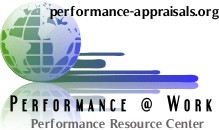Employee Rating Systems: Most Used Method, Perhaps The Least Useful
Top : Employee Rating Systems - The most used method of employee and performance appraisal involves the use of various rating scales. It's also a very weak and flawed method for improving performance. Here you will find more information on rating systems, their problems, and how to use.
Here's a short video explaining the number one problem with how ratings are used to create a single composite score reflecting an employee's "value". What is it? Mathematically, it's incorrect to add up the individual ratings.
Employee rating systems have much more value to the HR department than they do for improving performance, yet they are the most popular way of "assessing" employee performance. That's because it's easy to tick off boxes, and consider the process of discussing performance as complete, and so that's often what managers do. HR departments like them because they can offer a single standardized way of evaluating performance that applies to all employees, regardless of responsibility.
Of course the result is generic and general junk that often comes across as a kindergarten report card. What's worse is that this weak and unreliable data is then used to make personnel decisions in ways that are just plain wrong.
Well, we have to live with these realities, until such point as there's enough will in organizations to actually make a commitment to performance management as a way to improve employee engagement and productivity.
Sources For Additional Information About Employee Rating Systems:
By Fred C. Lunenburg - Journal article outlining problems with employee rating forms and some alternatives: Excerpt: Performance appraisal is the systematic observation and evaluation of employees' performance. Some of the most commonly used performance appraisal methods include the judgmental approach, the absolute standards approach, and the results-oriented approach. Ideally, performance appraisal should be completely accurate and objective. However, the performance appraisal process is far from accurate and objective, sometimes resulting in rating errors. Common rating errors include strictness or leniency, central tendency, halo effect, and recency of events. Viewed 643 Times )
By Robert Bacal - Employee ratings are almost useless in helping to improve individual employee performance. The reasons are outlined here. Viewed 2392 Times )
By Robert Bacal - Employee ratings tend to be very subjective, but not all rating systems are alike. Some are more likely to yield more objective ratings than others. It's explained here. Viewed 2329 Times )
By Robert Bacal - Rating systems have the appearance of objectivity, but that's deceptive. Find out about employee ratings and objectivity in our short FAQ Viewed 2300 Times )
By Robert Bacal - BARS stands for Behaviorally Anchored Rating Scale, and was developed by Smith and Kendall to provide a better method of rating employees. Here's some basic information. Viewed 2249 Times )
By Robert Bacal - Find out whether BARS - Behaviourally Anchored Rating Scales - is actually better than other systems of employee rating. Viewed 2576 Times )
By na - If you use ratings in your evaluation procedure, you should understand the major biases that can skew the results and affect fairness. Here's a list: The Halo Effect Contrast Errors Recency Bias Leniency Bias Severity Bias Self Serving Bias Viewed 547 Times )
By Aharon Tziner; Christine Joanis; Kevin R Murphy - The effects of rating scale formats on several indices of the usefulness of performance appraisal for employee development were examined. The job performance of 96 police officers was rated using simple graphic scales or one of two behaviorally oriented rating formats: behaviorally anchored rating scales (BARS) and behavior observation scales (BOS). As predicted, ratees' satisfaction with performance appraisal was highest and their perceptions of performance goals most favorable when using BOS. In addition, performance improvement goals for officers rated using BOS were judged by experts to be most observable and specific. Contrary to the authors' predictions, graphic rating scales were generally as good as BOS and as good as or better than BARS when evaluated in terms of ratee attitudes and goal characteristics. The results suggest that different behaviorally-oriented rating formats can enhance or inhibit the developmental applications of performance appraisal Viewed 962 Times )
By AJ Schuler - Fairly good coverage of the reasons why employee ratings get inflated and what to do about it. Viewed 904 Times )
By Robert Bacal - Central tendency bias is a common bias that tends to contaminate ratings of employees' effectiveness. Viewed 1713 Times )
By Robert Bacal - Rater bias is an important factor in the use of employee ratings. Here's what the term means. Viewed 1774 Times )
|
Library Home Page |
Pages Updated On:
6-Sep-2016
-
15:26:57
We can help you with the various parts of a performance management system with our miniguides on each component.
Instantly downloadable and built to save you time.
There's even help for employees on how to navigate the process.


